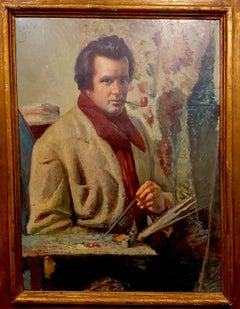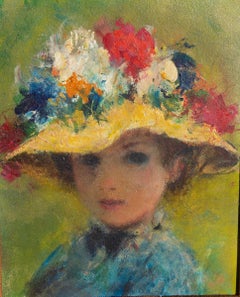Paulo Ghiglia Art
to
1
Overall Width
to
Overall Height
to
1
1
1
1
1
1
1
1
1
1
1
1
10,027
2,758
1,380
1,375
1
Artist: Paulo Ghiglia
Self Portrait - Oil on Masonite by Paulo Ghiglia - 1937
By Paulo Ghiglia
Located in Roma, IT
Signed on top left side P. Ghiglia 937.
Good conditions.
Category
1930s Paulo Ghiglia Art
Materials
Oil
Related Items
French Impressionist Painting Portrait of a Young Girl Paris School
Located in Rochester, NY
Striking French impressionist portrait of a young girl. Oil on board. Original carved frame. Circa 1950's. Signed illegibly lower right.
Category
Mid-20th Century Impressionist Paulo Ghiglia Art
Materials
Oil
$1,275
H 17 in W 15 in D 2 in
Our Time, Our Fashion - 21st Century, Contemporary, Figurative, Black Women
Located in Ibadan, Oyo
Shipping Procedure
Ships in a well-protected tube from Nigeria
This work is unique, not a print or other type of copy.
Accompanied by a Certificate of Authenticity.
About Artist
Ade...
Category
21st Century and Contemporary Contemporary Paulo Ghiglia Art
Materials
Canvas, Oil, Acrylic
$2,850
H 59.5 in W 44 in D 1 in
Quiet Vessel - 21st Century, Contemporary, Figurative Portrait, Modern, Africa
Located in Ibadan, Oyo
So many memories, thoughts, and feelings we never want to forget—they refuse to fade away.
In this place, the clock does not tick; everything is suspended in time.
It is as if the w...
Category
21st Century and Contemporary Expressionist Paulo Ghiglia Art
Materials
Canvas, Oil, Acrylic
$1,950
H 27 in W 27 in D 1 in
"Glimmer" (2024) Oil Painting by Karen Offutt, Nude Female Portrait
By Karen Offutt
Located in Denver, CO
Karen Offutt's (US based) "Glimmer" is an original, handmade oil painting that depicts a nude female wearing a translucent robe, posing with her arms above her head. The painting is ...
Category
21st Century and Contemporary Realist Paulo Ghiglia Art
Materials
Oil, Panel
$3,000
H 16 in W 12 in D 0.25 in
Seaside Café Scene – Figurative Impressionist Oil on canvas Signed, Ornate Frame
Located in Palm Coast, FL
Offered for sale is a vibrant and whimsical oil on canvas, signed in the lower right, depicting an elegant seaside café scene. The composition shows three stylishly dressed women sea...
Category
Late 20th Century Impressionist Paulo Ghiglia Art
Materials
Oil
$680
H 23.5 in W 29.5 in D 2 in
20th Century Oil on Canvas Italian Religious Painting Saint Roch with Dog, 1930
Located in Vicoforte, IT
Great Italian painting from the first half of the 20th century. Artwork oil on canvas, on the first canvas, depicting a religious subject Saint Roch with dog and stick of good pictor...
Category
1930s Paulo Ghiglia Art
Materials
Canvas, Oil
$4,195
H 55.12 in W 42.52 in D 1.97 in
"Blue Eyed Girl with Pearls" By Suchitra Bhosle, Original Portrait Oil Painting
By Suchitra Bhosle
Located in Denver, CO
Suchitra Bhosle's "Blue Eyed Girl with Pearls" is an original, handmade oil painting that depicts a portrait of a young woman.
About the Artist:
Suchitra Bhosle is an India-born ar...
Category
2010s Impressionist Paulo Ghiglia Art
Materials
Oil, Board
"Luster" (2024) Oil Painting by Karen Offutt, Female Portrait
By Karen Offutt
Located in Denver, CO
Karen Offutt's (US based) "Luster" is an original, handmade oil painting that depicts a portrait of a woman on an abstracted background. The painting is framed, with overall dimensio...
Category
21st Century and Contemporary Realist Paulo Ghiglia Art
Materials
Oil, Panel
$1,975 Sale Price
26% Off
H 12 in W 10 in D 0.25 in
"Jane in Profile" By Suchitra Bhosle, Original Portrait Oil Painting
By Suchitra Bhosle
Located in Denver, CO
Suchitra Bhosle's "Jane in Profile" is an original, handmade oil painting that depicts a young woman in deep contemplation.
About the Artist:
Suchitra Bhosle is an India-born artis...
Category
2010s Impressionist Paulo Ghiglia Art
Materials
Oil, Board
"Spark" (2024) Oil Painting by Karen Offutt, Nude Female Portrait
By Karen Offutt
Located in Denver, CO
Karen Offutt's (US based) "Spark" is an original, handmade oil painting that depicts a nude female on an abstracted background. The painting is framed, with overall dimensions of 18 ...
Category
21st Century and Contemporary Realist Paulo Ghiglia Art
Materials
Oil, Panel
$3,000
H 16 in W 12 in D 0.25 in
French Contemporary Art by Karine Bartoli - Caspiu
By Karine Bartoli
Located in Paris, IDF
Oil on canvas
Karine Bartoli was born in 1971 in Ajaccio. She enrolled at the Ecole Nationale Superieure des Beaux Arts in Marseille where she graduated in 1997. Since then she has ...
Category
2010s Contemporary Paulo Ghiglia Art
Materials
Canvas, Oil
$2,600
H 38.19 in W 51.19 in D 1.58 in
Portrait of a woman in front of a landscape in a trompe l'œil
Located in BELEYMAS, FR
French school circa 1810
Portrait of a woman in front of a landscape in a trompe l'oeil
H. 106 cm; L. 91 cm
Oil on canvas
Preserved in its original vine leaf frame, this large portr...
Category
1840s French School Paulo Ghiglia Art
Materials
Canvas, Oil
$9,349
H 41.74 in W 35.83 in
Paulo Ghiglia art for sale on 1stDibs.
Find a wide variety of authentic Paulo Ghiglia art available for sale on 1stDibs. You can also browse by medium to find art by Paulo Ghiglia in oil paint, paint and more. Not every interior allows for large Paulo Ghiglia art, so small editions measuring 20 inches across are available. Customers who are interested in this artist might also find the work of Antonio Feltrinelli, Lazzaro Donati, and Leon Kroll. Paulo Ghiglia art prices can differ depending upon medium, time period and other attributes. On 1stDibs, the price for these items starts at $9,469 and tops out at $9,469, while the average work can sell for $9,469.


